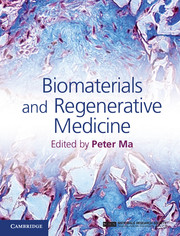Book contents
- Frontmatter
- Contents
- List of contributors
- Preface
- Part I Introduction to stem cells and regenerative medicine
- Part II Porous scaffolds for regenerative medicine
- 7 Nanofibrous polymer scaffolds with designed pore structure for regeneration
- 8 Electrospun micro/nanofibrous scaffolds
- 9 Biological scaffolds for regenerative medicine
- 10 Bioceramic scaffolds
- 11 Collagen-based tissue repair composite
- 12 Polymer/ceramic composite scaffolds for tissue regeneration
- 13 Computer-aided tissue engineering for modeling and fabrication of three-dimensional tissue scaffolds
- Part III Hydrogel scaffolds for regenerative medicine
- Part IV Biological factor delivery
- Part V Animal models and clinical applications
- Index
- References
12 - Polymer/ceramic composite scaffolds for tissue regeneration
from Part II - Porous scaffolds for regenerative medicine
Published online by Cambridge University Press: 05 February 2015
- Frontmatter
- Contents
- List of contributors
- Preface
- Part I Introduction to stem cells and regenerative medicine
- Part II Porous scaffolds for regenerative medicine
- 7 Nanofibrous polymer scaffolds with designed pore structure for regeneration
- 8 Electrospun micro/nanofibrous scaffolds
- 9 Biological scaffolds for regenerative medicine
- 10 Bioceramic scaffolds
- 11 Collagen-based tissue repair composite
- 12 Polymer/ceramic composite scaffolds for tissue regeneration
- 13 Computer-aided tissue engineering for modeling and fabrication of three-dimensional tissue scaffolds
- Part III Hydrogel scaffolds for regenerative medicine
- Part IV Biological factor delivery
- Part V Animal models and clinical applications
- Index
- References
Summary
Biomimetics: nature provides the template
Where does a tissue engineer look for inspiration? What is the gold standard to which we hold our designs? Since antiquity, humankind has looked at the world around it for clues as to how we can improve our quality of life, and the gaze of the tissue engineer finds its way there as well. The metamorphosis of this inspiration into technology for the improvement of humankind is the mission of the engineer.
Complex structures are often found performing incredible feats in nature [1]. For example, brachiopod and mollusk shells are subjects of current study, due to their amazingly strong, layered structure [2, 3]. This natural composite structure is being used as inspiration for tissue-engineered structures for cortical bone. This is an example of nature-as-inspiration by utilizing composite material systems for bone tissue engineering scaffold design, an area of great success already, with potential for further advancement. The human body provides a model where collagen fibers are mineralized in a precise manner, resulting in a network of ceramic nanoscale crystals interspersed with an organic mesh. This leads to a hierarchical structure comprising these components and creating bone tissue, which through its complexity derives requisite qualities such as strength, toughness, fatigue life, and nutrient transfer [4]. This example is a common one, but not the only one. In fact, any scaffold design that incorporates one or more aspects of the naturally occurring extracellular matrix (ECM) is biomimetic by definition. In fact, in a broader sense so is any engineering design that borrows from nature. “What has fins like a whale, skin like a lizard and eyes like a moth? The future of engineering.” Tom Mueller’s question posed in National Geographic no doubt ignites a sense of wonderment resulting in brainstorming sessions about countless unsolved engineering problems, but we must focus. Within the scope of this chapter, we will focus on biomedical engineering, and more specifically polymer/ceramic composite scaffold design for use in tissue regeneration.
- Type
- Chapter
- Information
- Biomaterials and Regenerative Medicine , pp. 203 - 214Publisher: Cambridge University PressPrint publication year: 2014



